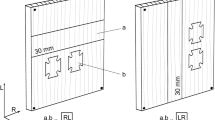Abstract
Longitudinal and flexural vibration tests were conducted using open-hole Sitka spruce specimens, and the effects of the size and location of the open hole on the measurement of the nominal Young’s modulus and nominal shear modulus were investigated. The nominal elastic moduli often decreased as the size of the open hole increased, and the hole was located close to the mid-length of the specimen. However, the decreasing tendencies were characterised according to the direction along which the vibration was excited. To consider these phenomena, an empirical equation for deriving the nominal elastic modulus corresponding to the size and location of the open hole is proposed. The effects of the open hole were appropriately predicted using the proposed equation.










Similar content being viewed by others
References
Aicher S, Höfflin L (2008) Fracture behaviour and design of glulam beams with round holes. In: Proceedings of the 10th world conference of timber engineering, No. 1. pp 132–140
Brancheriau L (2014) An alternative solution for the determination of elastic parameters in free–free flexural vibration of a Timoshenko beam. Wood Sci Technol 48:1269–1279
Brancheriau L, Bailleres H (2002) Natural vibration analysis of clear wooden beams: a theoretical review. Wood Sci Technol 36:347–365
Daudeville L, Yasumura M (1996) Failure analysis of timber bolted joints by fracture mechanics. Mater Struct 29:418–425
Eckelman CA (1975) Effect of holes on the bending strength of wood and particleboard parts. Purdue Univ Res Bull 922:1–8
Eckelman CA, Erdil YZ, Haviarova E (2002) Effect of cross holes on the strength of chair and table legs. For Prod J 52:67–70
Falk RH, DeVisser D, Plume GR, Fridley KJ (2003) Effect of drilled holes on the bending strength of large dimension Douglas-fir lumber. For Prod J 53:55–60
Fujimoto Y, Mori M (1983) Effect of stress concentration on strength of wooden member with an artificial circular hole. Sci Bull Fac Agric Kyushu Univ 38:17–25
Goens E (1931) Über die Bestimmung des Elastizitätsmoduls von Stäben mit Hilfe von Biegungsschwingungen. (Determination of Young’s modulus from flexural vibrations) (in German). Ann Phys Ser 7(11):649–678
Hearmon RFS (1946) The elastic constants of anisotropic materials. Rev Modern Phys 18:409–440
Hearmon RFS (1966) Vibration testing of wood. For Prod J 16:29–40
Jeleč M, Varevac D, Zovkić J (2014) Glulam beams with holes. Electron J Fac Civ Eng Osijek-e-GFOS 5:22–33
Kubojima Y, Yoshihara H, Ohta M, Okano T (1997) Accuracy of the shear modulus of wood obtained by Timoshenko’s theory of bending. Mokuzai Gakkaishi 43:439–443
Noguchi M, Nakamura N (2011) Strength calculation method of timber beam with two holes. J Struct Const Eng AIJ 76:927–934
Noguchi M, Sakata H, Wada A, Miyazawa K (2009) A strength calculation method of single bolted timber joint loaded parallel to the grain. J Struct Const Eng AIJ 74:681–690
Patton-Mallory M, Pellicane PJ, Smith FW (1997) Modeling bolted connections in wood: review. J Struct Eng 123:1054–1062
Roohnia M, Tajdini A (2014) Identification of the severity and position of a single defect in a wooden beam. BioResources 9:3428–3438
Roohnia M, Tajdini A, Manouchehri N (2010) Effect of drillings as artificial defects on dynamic shear modulus of wood. In: Proceedings of the 40th international conference and NDT technique exposition, pp 211–218
Roohnia M, Alavi-Tabar S-E, Hossein M-A, Brancheriau L, Tajdini A (2011a) Dynamic modulus of elasticity of drilled wooden beams. Nondestruct Test Eval 26:141–153
Roohnia M, Manouchehri N, Tajdini A, Yaghmaeipour A, Bayramzadeh V (2011b) Modal frequencies to estimate the defect position in a flexural wooden beam. BioResources 6:3676–3686
Sawata K (2005) Strength of bolted timber joints subjected to lateral force. J Wood Sci 61:221–229
Schmidt J, Kaliske M (2007) Simulation of cracks in wood using a coupled material model for interface elements. Holzforschung 61:382–389
Sinha A (2014) Postpeak residual capacity of nailed connections of a shear wall. Holzforschung 68:987–992
Sjödin J, Serrano E (2006) A numerical study of the effects of stresses induced by moisture gradients in steel-to-timber dowel joints. Holzforschung 6:694–697
Sjödin J, Serrano E (2008) An experimental study of the effects of moisture variations and gradients in the joint area in steel timber dowel joints. Holzforschung 62:243–247
Sobue N, Fujita M, Nakano A, Suzuki T (2010) Identification of defect position in a wooden beam from the power spectrum of longitudinal vibration. J Wood Sci 56:112–117
Sohi AMA, Khademi-Eslam H, Hemmasi AH, Roohnia M, Talaiepour M (2011) Nondestructive detection on the effect of drilling on acoustic performance of wood. BioResources 6:2632–2646
Timoshenko SP (1921) On the correction for shear of the differential equation for transverse vibrations of prismatic bars. Philos Mag 41:744–746
Wilkinson TL, Rowlands RE (1981) Influence of elastic properties on the stress in bolted joints in wood. Wood Sci 14:15–22
Yoshihara H, Yoshinobu M (2015) Young’s modulus and shear modulus of solid wood measured by the flexural vibration test of specimens with large height/length ratios. Holzforschung 69:493–499
Yoshihara H, Ataka N, Maruta M (2016a) Analysis of the open-hole compressive strength of spruce. Holzforschung 70:449–455
Yoshihara H, Ataka N, Maruta M (2016b) Four-point bending strength of key-hole side-edge-notched western hemlock (Tsuga heterophylla) wood. Holzforschung 70:1073–1079
Author information
Authors and Affiliations
Corresponding author
Additional information
Publisher's Note
Springer Nature remains neutral with regard to jurisdictional claims in published maps and institutional affiliations.
Rights and permissions
About this article
Cite this article
Yoshihara, H., Maruta, M. Young’s modulus and shear modulus of open-hole spruce measured by vibration tests. Wood Sci Technol 53, 1279–1294 (2019). https://doi.org/10.1007/s00226-019-01130-y
Received:
Published:
Issue Date:
DOI: https://doi.org/10.1007/s00226-019-01130-y




